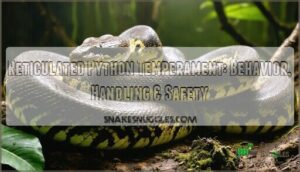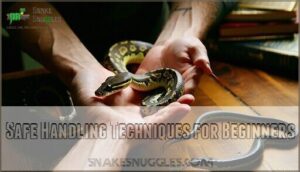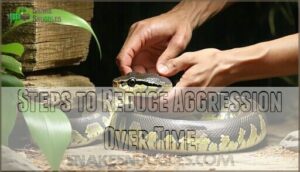This site is supported by our readers. We may earn a commission, at no cost to you, if you purchase through links.

Their behavior shifts dramatically across life stages, with hatchlings displaying nervous defensiveness that can mellow into calm tolerance through consistent, gentle interaction. Morphs like tigers and pieds often handle more predictably than others, but no retic is truly "tame"—they’re complex animals whose trust you earn through technique, not wishful thinking.
What separates a manageable giant from a dangerous one often comes down to reading signals most keepers miss.
Table Of Contents
Key Takeaways
- Reticulated python temperament stems from genetics, early handling, and environment rather than pure instinct, with captive-bred individuals from docile lineages showing 30% less aggression than wild-caught specimens. – Intelligence distinguishes these snakes from other constrictors—they solve escape puzzles 35% faster than Burmese pythons, remember handlers, and demonstrate spatial learning that improves with environmental enrichment. – Temperament shifts dramatically across life stages, with 82% of hatchlings striking defensively while adults often mellow, though breeding cycles and feeding responses can trigger unpredictable aggression even in well-socialized specimens. – Safe handling requires reading defensive signals like rapid tongue flicks and S-shaped neck positioning, maintaining proper enclosure security with dual latches, and understanding that these giants demand experienced keepers capable of managing 16+ foot predators.
Reticulated Python Personality Traits
Every reticulated python has its own personality—some are calm and curious, while others can be a bit feisty. A lot depends on their genetics, how they’re raised, and where they are in life.
If you’re wondering what shapes their behavior as they grow, here’s what you should know.
Typical Behavioral Characteristics
When you first encounter a reticulated python, you’re meeting one of the most behaviorally complex constrictors in the reptile world—a species whose personality can shift as dramatically as the intricate patterns along its scales.
Reticulated pythons act on a mix of instinct and experience. When they feel cornered or stressed, you’ll see quick tongue flicks, stiffened bodies, and sometimes even a sudden strike.
Activity patterns tend toward crepuscular hunting rhythms, though captive individuals adapt to their keeper’s schedule.
Communication methods rely on chemical signals and body language rather than vocalizations, making snake temperament sometimes harder to read than warm-blooded pets.
Intelligence and Problem-Solving Abilities
Beyond basic instincts, you’re working with a snake that actually thinks. Reticulated pythons demonstrate spatial learning that improves 27% with environmental complexity, and they can solve escape puzzles 35% faster than Burmese or ball pythons. Their cognitive enrichment responses show measurable intelligence—they’ll rearrange enclosure items, recognize familiar people through social recognition, and remember negative experiences that shape future defensive behavior. However, these snakes are also known to thrive in various urban environments, adapting to different habitats alongside humans.
Here’s where they really stand out:
Their object manipulation skills allow them to intentionally modify their surroundings for comfort. Comparative problem-solving tests place them in the top 10% of constrictors for strategic thinking. Maze navigation improves considerably with brain volume increases up to 3.2% in enriched environments. Memory retention for novel objects exceeds 80% after a week, demonstrating lasting recall.
This reticulated python behavior directly influences snake temperament—smarter snakes respond to patterns, remember handlers, and adapt their reactions based on experience.
Differences Between Wild and Captive-Bred Retics
The gap between wild aggression and captive docility in reticulated pythons isn’t subtle—it’s dramatic. Wild-caught retics exhibit defensive striking in over 80% of initial encounters, while captive-bred individuals drop below 20% when handled from the hatchling stage. Acclimation speed tells the same story: wild specimens need six months to settle into new environments, but captive-bred retics adjust in under two months.
Lifespan variance favors captive-bred snakes, averaging 24–30 years compared to 12–23 for their wild counterparts. Socialization success rates reveal the clearest divide—79% of captive-born pythons master basic target training within 90 days, while wild-caught individuals achieve this in fewer than 9% of cases.
Building trust with snakes becomes exponentially easier when reticulated python handling starts early, making captive-bred retics the clear choice for anyone serious about reticulated python temperament and long-term behavioral predictability. These snakes are considered temperamental snake species, requiring experienced handlers.
Temperament Variation Across Life Stages
Hatchling reticulated pythons don’t act like miniature versions of adults—they’re wired for survival in ways that reshape completely as they mature. Hatchling defensiveness peaks early—82% strike when threatened—because predation risk runs high.
Juvenile docility emerges around 18 months as growth reduces vulnerability. Adult aggression resurfaces unpredictably during breeding cycles or feeding responses.
Temperament shifts follow maturation impact patterns, making snake handling techniques and building trust with snakes essential throughout each life stage of reticulated python behavior.
Factors Influencing Reticulated Python Temperament
Because pythons change so much as they grow, learning how to handle them and earn their trust is important at every stage of their lives.
Your reticulated python’s temperament isn’t set in stone—it’s shaped by a mix of factors you can influence. Understanding what drives their behavior helps you create the right conditions for a calmer, more predictable snake.
Genetics and Morph Influence
Your reticulated python isn’t born with a set personality—how it acts depends on a bunch of things you can actually shape. Once you get what makes them tick, it becomes a lot easier to set the stage for a snake that’s calm and easier to handle.
Your reticulated python’s temperament isn’t just shaped by experience—genetics play a powerful role. Morph temperament patterns reveal surprising differences: tiger morphs tend toward docility, while pied and platinum varieties often display more reactive personalities.
Consider these genetic influences on reticulated python behavior:
- Breeding for docility has reduced aggression rates by over 30% in select lineages
- Piebald morphs exhibit statistically higher defensive strike rates than tigers
Here’s how genetics can shape the way your reticulated python acts:
- Population statistics show tiger and ghost morphs dominate sales due to easier snake handling
- Genetic influence varies—super-tigers demonstrate markedly decreased hostility compared to wild-type specimens
Selective breeding programs targeting temperament improvements have transformed captive reticulated python populations, making certain morphs considerably more suitable for handlers seeking predictable, less defensive snakes.
Impact of Early Handling and Socialization
The first few weeks of a reticulated python’s life can quietly determine whether you’ll handle a confident companion or a defensive striker for years to come.
Early interaction impact shapes reticulated python temperament profoundly—consistent, gentle handling reduces fear and aggression through habituation techniques.
Socialization benefits include decreased defensive strikes and improved taming outcomes. Snake handling during this critical window establishes long-term effects, transforming reticulated python behavior from reactive to predictable.
Environmental Stressors and Habitat Conditions
Your python’s mood won’t shift on a whim—it responds directly to the invisible pressures lurking in its enclosure. Snake habitat shortcomings trigger stress responses that ripple into temperament problems. Temperature gradients must replicate natural conditions, while humidity levels and substrate type influence comfort. When reticulated python habitat lacks proper enclosure size or enrichment options, defensive behavior escalates.
- Cramped snake enclosures turn calm giants into coiled tension waiting to strike
- Incorrect snake temperature leaves your retic irritable, lethargic, or dangerously unpredictable
- Poor snake humidity causes shedding complications that heighten aggression and discomfort
Health and Behavioral Correlations
When disease strikes, your retic’s behavior transforms—respiratory infections trigger open-mouth breathing and feeding response shutdown within 10–12 weeks, while parasitic loads cause withdrawal and lethargy.
Malnutrition effects include stunted growth and weakened immune function, making your snake more prone to stress disorders and defensive aggression.
Aging temperament generally mellows; older pythons show reduced snake aggression factors as metabolic rates drop.
Trauma impact from injuries increases defensive posturing until recovery, sometimes permanently altering snake behavior through heightened reactivity.
Handling and Building Trust With Reticulated Pythons
Building trust with a reticulated python takes patience and an understanding of how these intelligent constrictors communicate.
Here’s how to handle your retic safely and recognize when they’re telling you to back off.
Safe Handling Techniques for Beginners
You need to know two things: how to hold your retic without spooking them, and what their body language means when they’ve had enough.
Handling a snake that can grow longer than your living room sofa requires more than confidence—it demands technique, respect, and a clear understanding of what you’re working with. Start with younger, smaller specimens to build your skills gradually. Always approach your python with calm, deliberate movements—sudden gestures can trigger defensive reactions. Snake bite prevention begins with proper equipment and situational awareness.
Essential handling practices include:
- Bear the body fully – Distribute weight across multiple contact points, using both hands to prevent the snake from feeling insecure or dropped
- Avoid feeding days – Never handle within 48 hours of feeding to reduce stress and regurgitation risk
- Use a snake hook initially – Proper equipment like hooks helps establish boundaries and reduces aggression during early interactions
- Keep sessions brief – Limit handling to 10-15 minutes when starting out, allowing gradual introduction to human contact
- Have a safety plan – Know emergency procedures and never handle alone, especially as your retic grows beyond 10 feet
Recognizing Defensive Postures and Warning Signs
Reading your retic’s body language can mean the difference between a smooth handling session and a trip to the emergency room. Defensive signals show up clearly: rapid tongue flicking, body tension like a coiled spring, and an S-shaped neck positioning within striking distance.
Watch for breathing changes—heavy, deliberate exhales often precede a bite attempt. When your reticulated python displays these snake behavior patterns, back off immediately. Recognition prevents aggression from escalating into a safety crisis.
Steps to Reduce Aggression Over Time
Taming aggression isn’t about domination—it’s about consistency, patience, and reading the signs your snake sends you every single time you interact. Gradual exposure reduces defensive responses in your reticulated python:
- Start with brief, predictable handling sessions
- Use consistent interaction timing to build routine
Taming aggression isn’t about showing who’s boss—it’s about being consistent, staying patient, and learning what your snake’s body language is telling you.
The more predictable and calm you are during handling, the less defensive your reticulated python becomes over time.
- Introduce enrichment activities between handling
- Increase handling frequency slowly as trust develops
Positive reinforcement through calm, non-threatening movements transforms aggressive behavior into tolerance.
Socialization Best Practices
Building a foundation of trust isn’t a one-and-done process—it’s an ongoing relationship that requires exposing your reticulated python to varied, controlled experiences throughout its life.
Early socialization sets the stage for reducing stress and aggressive responses. Regular handling frequency—without overdoing it—reinforces positive reinforcement while environmental enrichment keeps your snake mentally engaged.
These practices work together, minimizing bite attempt risks and gradually taming defensive behaviors as trust deepens between you and your retic.
Safety Considerations for Owners and Handlers
Owning a reticulated python means understanding the serious risks that come with their size and strength.
Let’s walk through the key safety measures you need to protect yourself, your family, and your snake.
Reticulated pythons aren’t your average pet. These snakes get massive, and with that size comes real danger—not just for you, but for anyone in your household.
Before you bring one home, you need a solid safety plan. Here’s what that looks like.
Anyone who’s ever locked eyes with a twenty-foot constrictor knows that preventing a bite isn’t just about quick reflexes—it’s about reading the signals your snake sends long before those jaws open. Watch for rapid tongue flicks, tense coiling, and defensive postures before handling.
If bitten, don’t yank away—gently unhook the teeth to minimize tearing. Clean wounds thoroughly and monitor for infection.
After aggressive incidents, give your retic space before resuming handling sessions to rebuild trust.
Housing and Enclosure Security
A locked cage means nothing if your reticulated python can push the door open with ten pounds of muscle behind its snout. Secure housing demands:
- Enclosure size matching your snake’s length (minimum perimeter twice body length)
- Secure locking mechanisms—dual latches or padlocks on all access points
It doesn’t matter if the cage is locked—if your reticulated python can muscle the door open, you’re back to square one. True security starts with:
- Temperature control zones preventing thermal stress
- Environmental enrichment like branches reducing boredom-driven escape behavior
Your reticulated python housing isn’t just containment—it’s your safety net.
Risks of Large Snake Ownership
When you own a reticulated python, you’re accepting risks that go beyond handling. Abandonment incidents have surged—four retics were dumped in North Lincolnshire in 2025 alone—because owners underestimate adult size and costs.
Large constrictors caused ten U.S. fatalities over 23 years, and zoonotic diseases like salmonella affect 35% of exotic pet interactions.
Legal challenges persist due to weak regulations, while financial burdens for rescue and veterinary care regularly exceed $100 per snake, not counting long-term housing expenses.
Special Considerations for Children and Pets
If children or other pets share your home, you’ll need to weigh supervision demands against predatory instincts that don’t disappear with domestication. Responsible ownership means education on reticulated python safety before any interaction occurs.
- Never allow unsupervised handling—even docile retics can bite if startled, and children lack the strength to respond appropriately during aggressive episodes.
- Keep dogs and cats separated—their movements trigger feeding responses, making pet interaction inherently dangerous.
- Teach child safety protocols—explain warning signs and establish strict no-contact rules during feeding or shedding periods.
Comparing Reticulated Python Temperament to Other Species
If you’re weighing whether a reticulated python fits your experience level, it helps to see how they stack up against other popular constrictors.
The comparisons below break down key temperament differences so you can make an informed choice.
Wondering if a reticulated python is right for you? Looking at how they compare to other constrictors gives you a clearer picture of what you’re signing up for.
Burmese pythons offer a calmer, more predictable temperament that makes handling them less nerve-wracking than working with reticulated pythons. While both species grow impressively large—Burmese pythons reaching 23 feet and reticulated pythons exceeding 30 feet—reticulated pythons display faster, more anxious reactions and higher bite rates.
You’ll notice Burmese pythons show greater tolerance for routine handling, whereas reticulated pythons demand considerable experience due to their aggressive postures and heightened defensive strikes.
Reticulated Pythons Vs. Ball Pythons
Ball pythons feel like night-and-day different from reticulated pythons when you compare docility and handling safety.
Over 90% of ball pythons display calm, non-aggressive behavior in captivity, while up to 60% of reticulated pythons strike defensively during initial handling.
Ball python bites are medically insignificant, but reticulated python bites require medical attention 40% of the time due to deep lacerations.
Suitability as Pets for Different Experience Levels
Choosing your first giant constrictor isn’t a decision you make lightly—experience level directly determines whether you’ll thrive with a reticulated python or face serious safety challenges. Beginner retic ownership isn’t advisable because handling challenges escalate as these snakes mature into 16+ foot predators capable of inflicting severe bites.
Experience-based suitability breakdown:
- Beginners: Ball pythons or corn snakes; reticulated pythons require commitment beyond novice capabilities
- Intermediate keepers: Dwarf retics (under 10 feet) with established handling protocols and bite-response training
- Experienced keepers only: Full-sized reticulated pythons demand sophisticated restraint techniques and size considerations
- Specialists: Mainland locality retics displaying elevated defensive behaviors and aggressive tendencies
- Professional facilities: Wild-caught specimens requiring quarantine expertise and behavioral rehabilitation
Pet snake ownership becomes exponentially more complex when your animal can overpower you physically.
Frequently Asked Questions (FAQs)
Can reticulated pythons recognize their owners over time?
Do reticulated pythons actually remember you, or is recognition just wishful thinking? While snakes lack mammalian bonding mechanisms, experienced keepers report that captive-bred reticulated pythons distinguish familiar handlers from strangers.
They show reduced defensive responses and greater tolerance over time—not affection, but learned trust through consistent, non-threatening interaction.
How do feeding responses affect daily temperament?
When feeding time approaches, your reticulated python’s aggressive feeding response can temporarily increase defensive behaviors, making even calm individuals more reactive.
Post-feeding behavior usually shifts to lethargy as prey size affects digestive demands and temperament.
Do retics show territorial behavior in captivity?
While not strictly territorial like mammals, captive-bred retics can display enclosure aggression and resource guarding behaviors, particularly near feeding areas or preferred basking zones.
Space competition and stress indicators increase these defensive responses in smaller enclosures.
What triggers sudden temperament changes in adults?
What actually causes sudden temperament changes in adults? Hormonal shifts during breeding season can trigger aggressive attacks, while environmental triggers like temperature fluctuations or enclosure changes heighten stress responses.
Social interactions, illness, and feeding habits also disrupt trust in reticulated python care.
Are certain morphs calmer than others genetically?
You won’t find solid evidence that specific morphs inherit calmer dispositions. Morph behavior and genetic calmness in reticulated python care remain unproven—breeders report calmer strains, but inherited temperament likely stems from handling practices rather than genetic predisposition to reduced aggressive responses.
Conclusion
Paradoxically, understanding a reticulated python temperament profile means accepting that predictability comes from respecting unpredictability. These snakes don’t fit simple categories—their behavior reflects genetics, handling consistency, and environmental care working together.
True respect for reticulated pythons means accepting that their predictability comes from honoring their unpredictable nature
You can’t eliminate risk with giants this powerful, but you can minimize it through proper technique and honest assessment of your capabilities.
Read their signals, honor their boundaries, and remember that trust with retics isn’t ownership—it’s partnership built on mutual respect and knowledge.

















